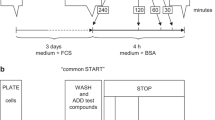Summary
The effects of insulin and somatostatin on the growth and the colony formation of two human pancreatic cancer cell lines, BxPC-3 and SOJ-6, were studied. The BxPC-3 cell line (American Type Culture Collection no. CRL 1687) was derived from a moderately differentiated pancreatic adenocarcinoma. The SOJ-6 cell line is a subclone of SOJ that was initiated from ascites of a well-differentiated pancreatic adenocarcinoma. Both cell lines express fetoacinar pancreatic antigen, an antigen that might be associated with early transformation stages. However, these lines have different proliferation and tumoral powers. SOJ-6 cells showed an almost twofold higher division rate over BxPC-3 cells when cultured in RPMI-1640 medium containing 10% fetal bovine serum. The tumorigenic degree of SOJ-6 cells, as assessed by tumor growth in nude mice, was about three times greater than that of BxPC-3. The in vitro growth of BxPC-3 cells was significantly promoted by insulin, and was slightly inhibited by somatostatin, whereas the growth of SOJ-6 cells was not influenced by these hormones. Using a clonogenic assay in soft agar, the average ratio of colony numbers formed by SOJ-6 and BxPC-3 was about 10/1, indicating a good correlation between the colony formation and tumorigenic degree in vivo. In this test, the number of colonies formed by BxPC-3 cells was increased about twofold in insulin-supplemented medium. On the other hand, somatostatin inhibited the colony formation by a factor of four to six. However, no hormonal modulation of the colony formation of SOJ-6 cells was observed. Our data show that pancreatic cancer cell lines respond differently to pancreatic hormones, and suggest that this may be correlated to a tumour stage or a tumour type.
Similar content being viewed by others
Abbreviations
- FAP antigen:
-
fetoacinar pancreatic antigen
- FBS:
-
fetal bovine serum
- PBS:
-
phosphate-buffered saline
- RPMI-1640:
-
Roswell Park Memorial Institute's Medium 1640
- CEA:
-
carcinoembryonic antigen
- CA 19-9:
-
carbohydrate antigen 19-9
References
Albers GHR, Escribano MJ, Daher N, Nap M (1990) FAP protein in the normal pancreas, chronic pancreatitis, pancreatic adenocarcinoma and intraabdominal metastasis of adenocarcinomas. An immunological study. Am J Clin Pathol 93:14–20
Bockman DE (1981) Cells of origin of pancreatic cancer: experimental animal tumors related to human pancreas. Cancer 47:1528–1534
Carre-Llopis A, Loridon-Rosa B, Escribano M (1987) Ultrastructual changes in acinar cells of hamster pancreas in chemically induced carcinogenesis. Cell Biol Int Rep 11:no.9
Eriguchi M, Carre-Llopis A, Orbach-Arbouys S, Escribano MJ (1987) Evolution of expression of fetal acinar antigens during carcinogenesis of the pancreas of hamster: individual follow-up by open biopsy. JNCI 78:519–525
Escribano MJ, Carre-Llopis A, Loridon-Rosa B (1985) Expression of oncofetal pancreatic antigens in hamster adult pancreas during experimental carcinogenesis. Br J Cancer 51:187–193
Faivre J, Bedenne L, Arveux P, Klepping C (1990) Epi-démiologie descriptive du cancer du pancréas. Bull Cancer 77:39–46
Flaks B, Moore MA, Flaks A (1982) Ultrastructual analysis of pancreatic carcinogenesis: V. Changes in differentiation of acinar cells during chronic treatment withN-nitrosobis(2-hydroxypro-phyl) amine. Carcinogenesis 3:485–498
Fujii Y, Sekiguchi M, Shiroko Y, Shimizu H, Sugawara I, Hasumi K, Eriguchi M, Ikeuchi T, Uchida H (1990) Establishment and characterization of human pancreatic adeno-carcinoma cell line SOJ producing carcinoembryonic antigen and carbohydrate antigen 19-9. Hum Cell 3:31–36
Gonzalez-Barcena D, Rangel-Garcia NW, Perez-Sanchez PL et al. (1986) Response to D-Trp-6-LH-RH in advanced adeno-carcinoma of pancreas. Lancet 2:154
Lhoste EF, Roebuck BD, Stern JE, Longnecker DS (1987) Effect of orchiectomy and testosterone on the early stages of azaserine-induced pancreatic carcinogenesis in the rat. Pancreas 2:38–43
Lieberman I, Ove P (1959) Growth factors for mammalian cells in culture. J Biol Chem 234:2754
Longnecker DS (1990) Experimental pancreatic cancer: role of species, sex and diet. Bull Cancer 77:27–37
Macpherson I, Montagnier L (1964) Agar suspension cultures for the selective assay of cells transformed by polyoma virus. Virology 23:291–294
Mazo A, Fujii Y, Shimotake J, Escribano MJ (1991) Expression of FAP protein in the pancreatic human tumor cell line BxPC-3. Pancreas 6:37–45
Mossner J, Logsdon CD, Goldfine ID, Williams JA (1984) Regulation of pancreatic acinar cell insulin receptors by insulin. Am J Physiol 247:155–160
Paz-Bouza JI, Redding TW, Schally AV (1987) Treatment of nitrosamine-induced pancreatic tumors in hamsters with analogs of somatostatin and luteinizing hormone-releasing hormone. Proc Natl Acad Sci USA 84:1112–1116
Popiela H, Moore W (1989) Proliferation of immunocytochemically identified islet beta cells in culture: effect of growth factors, hormones, and nutrients. Pancreas 4:244–248
Poston GJ, Townsend Jr CM, Rajaraman S, Thompson JC, Singh P (1990) Effect of somatostatin and tamoxifen on the growth of human pancreatic cancers in nude mice. Pancreas 5:151–157
Redding TW, Schally AV (1984) Inhibition of growth of pancreatic carcinomas in animal models by analogs of hypothalamic hormones. Proc Natl Acad Sci USA 81:248–252
Roebuck BD, Baumgartner KJ, Thron CD (1984) Characterization of two populations of pancreatic atypical acinar cell foci induced by azaserine in the rat. Lab Invest 50:141–146
Sakamoto C, Goldfine ID, Williams JA (1984) The somatostatin receptor on isolated acinar cell plasma membranes. J Biol Chem 259:9623–9627
Tan MH, Nowak NJ, Loor R, Ochi H, Sandberg AA, Lopes C, Pickren JW, Bzrjian R, Douglass HO, Chu TM (1986) Characterization of a new primary human pancreatic tumor line. Cancer Invest 4:15–23
Williams JA, Goldfine ID (1985) The insulin-pancreatic acinar axis. Diabetes 34:980–986
Zalatnai A, Schally AV (1989) Treatment ofN-nitrosobis(2-oxopropyl)amine-induced pancreatic cancer in Syrian golden hamsters withd-Trp-6-LH-RH and somatostatin analogue RC-160. Cancer Res 49:1810–1815
Author information
Authors and Affiliations
Additional information
This work was financed in part with grant 6394 Association pour la Recherche sur le Cancer (ARC) (Villejuif). Y. Takeda was supported by a fellowship from the ARC
Rights and permissions
About this article
Cite this article
Takeda, Y., Escribano, M.J. Effects of insulin and somatostatin on the growth and the colony formation of two human pancreatic cancer cell lines. J Cancer Res Clin Oncol 117, 416–420 (1991). https://doi.org/10.1007/BF01612760
Received:
Accepted:
Issue Date:
DOI: https://doi.org/10.1007/BF01612760




